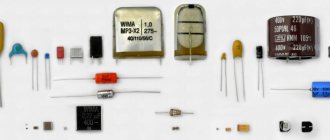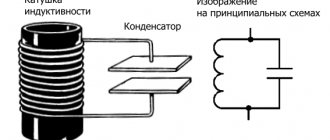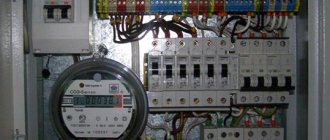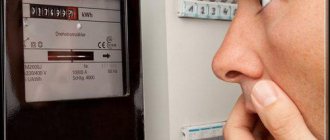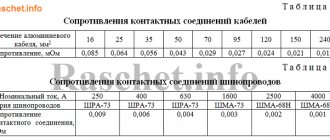- Turn off the ignition;
- All consumers operating with the ignition off are turned off: radio, security system;
- Disconnect the negative terminal of the power source;
- Switch the multimeter to the mode for measuring direct current with a power of up to 10A;
- Using alligator clips, connect the positive probe of the multimeter to the pole of the same name;
- The negative probe is connected to the negative terminal removed from the battery pole;
- A sign of the presence of leakage current will be a changing number on the meter display: the higher the value displayed on it, the higher the leakage current and the spontaneous discharge of the element in idle mode.
Determination of leakage current on a car battery
In batteries in which there is no leakage current, the meter screen will have three zeros separated by one dot.
How to check the battery charge with a multimeter and not damage the fragile electronic “stuffing” of the device? In order to avoid damaging its internal filling when checking various battery characteristics with a multimeter, it is necessary to set the correct measurement range. So, for example, when measuring the potential difference between the poles of a 12-volt battery, the device is set to the DC voltage measurement range of up to 20 V.
On a note. Measurements of the values of various characteristics using a multifunction meter are made starting from the highest range. This is necessary to avoid burning the internal filling of the meter and causing electrical injury.
Checking different types of batteries
Battery check
In order to measure the battery capacity, it is not necessary to use a multimeter - you can measure the value of this characteristic using programs and devices.
Checking the laptop battery capacity
In order to check the battery capacity of a laptop, you need to use special utilities: Battery Care, Aida (for Windows operating systems), coconutBattery (for Mac OS), which show the actual and manufacturer-declared value of this characteristic.
You can also check the laptop battery charge using the command line, in which you need to enter powercfg energy and press the Enter button. As a result of such actions, after about a minute, the system will issue the address of a detailed report on the state of the energy source and the entire power supply system of the computer.
Checking the phone battery capacity
You can measure the battery capacity of a mobile phone using special programs or a USB tester.
So, you can find out the battery capacity of a phone running Android OS using programs such as Nova Battery Tester, Battery HD Pro, Power Battery. These programs allow you to quickly and accurately obtain up-to-date information about the condition of the battery, predict the duration of its normal operation, and the need for replacement. This is especially important when using low-quality batteries that are prone to spontaneous swelling and leakage.
Checking the battery capacity of a screwdriver
The battery capacity of a screwdriver is determined by measuring the operating time of a fully charged power supply on the tool. If the obtained value is less than that indicated on the power supply case, then one or more of its internal elements have become unusable.
Checking the capacity of a car battery
The capacity of a car battery is measured using the algorithm described above with a load connected. Powerful lamps, radio tape recorders, and car compressors for inflating wheels are used as loads.
Measuring the capacity of 18650 batteries
18650 battery
The capacity of a battery of this type is measured using a tester or by connecting the load. The value of this characteristic for an 18650 battery is calculated according to the same principle as for a car battery.
Thus, knowing how to measure the battery capacity, you can control this important characteristic and promptly change the battery when its value drops below the maximum permissible level. Having no idea how to find out the capacity, you can operate a battery with a low value of this characteristic for a long time, which will negatively affect the equipment itself that operates from such an element.
Video
Checking the battery with a multimeter
The most important parameter of each battery is its battery capacity. It determines the amount of energy given to them for each period of time. This applies to all batteries from car to telephone. Knowing about them and understanding the device is important because using the wrong battery capacity can cause serious problems in starting these devices.
The units of measurement for this quantity are Amperes or Milliamps/hour. Based on this parameter, the battery for the equipment is selected, guided by the recommended values. If the recommendations are violated, for example, the car may not start in winter.
What it is
One of the most important characteristics of a battery is its capacity. It is based on its size that the battery is selected for each specific car. Problem-free engine starting at any time of the year depends on the capacity of the car battery.
So what is battery capacity? It represents the amount of energy that a fully charged battery is capable of delivering in a certain period of time at a set value.
Designation on the body
The capacity of a car battery is measured in Ampere-hours (usually one hour is taken for a time period). You can find out the value of this parameter for any battery by looking at the label that is pasted on its case. The marking is as follows: 55 Ah. This means that with a current of 55 Amps the battery will be discharged over 20 hours - a full discharge cycle. Here we are talking about nominal capacity.
There is also the so-called reserve capacity of the battery, which determines the driving time of the car when the generator is not working in the winter at night. Its value is indicated in minutes. You can also find this parameter on the battery case label.
What is the capacity of a battery or accumulator
All batteries are usually decorated with inscriptions like 55, 70 Ah or 1800mAh. This designation indicates that the capacity of this battery is, respectively, 55 Amperes or fractions of Amperes per hour, only translated into English - A/hour. It must be distinguished from another parameter - voltage, which is written in Volts.
Standard battery
The Ah indicator shows how long the battery will work for an hour at a load of 60 Amps and a voltage of 12.7V. In other words, capacity is the amount of energy that a battery can hold.
And if there is less than 60A load, the battery will last longer than 60 minutes.
How to quickly check the capacity of any battery
Most often, battery capacity is measured using a tester. This is a device for quick measurements. It works automatically and does not require any additional knowledge to use it. The time required is no more than 15 seconds. All that is required is to connect the tester to a power source and press a single button, after which it begins to determine the capacity of the connected batteries.
It is used when choosing a battery, comparing the residual and nominal capacity, which is officially indicated on the device. If the difference is more than 50%, then the battery cannot be used.
Multimeter
If checking with a tester is not suitable and you need to accurately determine the current characteristics, you should switch to using a multimeter.
This is a fairly universal device, but it cannot be used independently to measure the capacity of a car’s starter battery. Here the multimeter acts as one of the components of a comprehensive test.
When measuring capacity with a multimeter, testing a car battery may require a load or a test discharge.
Load test
If we talk about effective schemes for measuring the real capacity of a starter battery for a car, then among them it is worth highlighting testing under load.
A car lamp from a headlight is usually used as a load.
By continuing testing, you can bring the battery to a deep discharge state. And sometimes even the most modern and efficient chargers cannot get rid of it.
When determining the load for capacitance measurement, amperage should be taken into account. With a nominal (nameplate) capacity of 60 Ah, the load should be 30 W
To check the battery capacity under load, you must:
- disconnect the battery from the generator;
- take voltage measurements;
- connect the load;
- let the battery run under load for 1–2 minutes;
- turn it off;
- connect a multimeter;
- take voltage measurements again.
If the multimeter shows 12.4–12.6 V, the battery capacity is maintained at a high level and the battery is functioning normally. If the multimeter shows 12 V or less, the power supply is probably at the limit of its capabilities and needs to be replaced.
There is also a control discharge technique, which is often used to check the capacity.
The multimeter connects to the battery and reads data until the current drops to 50–60% of the rated value. The resulting value is compared with the data from the data sheet. If the difference is large, the battery needs to be replaced.
Checking the battery capacity is not that difficult. But this will require certain equipment, some skills and abilities. If you don’t want to do all this yourself, you can always send the battery for diagnostics. They will check it using all available methods and issue a verdict on the current condition of the battery.
You can extend the battery life. Even if the lead plates have undergone sulfation. But sometimes there is no need to talk about recovery. The only way to return the machine to normal operation is to purchase a new power source.
Which device to use to accurately measure the capacity of any battery
The capacity indicator determines the density of electrolytes; it is determined using a special device - a hydrometer. New batteries always indicate the basic parameters. However, this value is determined independently.
Small battery
The simplest way is with ordinary testers like “Pendant”. This device is used to measure the capacity and voltage of the battery in a car. This requires minimal effort and time while achieving reliable results.
To use the “Pendant”, you need to connect it to the battery terminals, after which it will begin to determine the voltage and capacity.
There are many other ways to calculate these parameters. The classic method is to measure a car battery using a multimeter. In order to do this, it must be fully charged and connected to the consumer (an ordinary 60W light bulb is sufficient). However, even this does not guarantee absolute accuracy of the readings.
Multimeter device
The first step after assembling the circuit from the battery itself, a multimeter, or a light bulb is to apply voltage. If the light does not go out within 2 minutes (if this does not happen, the battery cannot be restored), take the “Coulomb” readings. As soon as the readings drop below battery voltage standards, the battery begins to discharge. Having measured the time required for the final consumption of energy and the load current of the consumer, you need to multiply these readings by each other. The resulting number is the battery capacity.
If the result differs from the official value, the battery must be replaced. A multimeter allows you to calculate the capacity of any battery. The disadvantage of this method is that it takes a lot of time.
In the second measurement method, the battery is discharged using a resistor according to a special circuit. Using a stopwatch, the discharge time is determined. However, it is important not to completely discharge the battery, protecting against this using a relay.
User Experience
Battery problems worried me two years ago, when I didn’t have a license. At first I couldn’t determine its capacity, but then I figured it out. The school offered to do a project on a free topic. I decided to study the correspondence of the parameters indicated on batteries from different manufacturers with their actual characteristics. I did this as a hobby, I did everything for the sake of interest. I didn’t think it would be useful later when I started driving.
Of course, I no longer completely discharge batteries; I use more advanced methods. I always plug in a solid-state relay so that there is no need to completely discharge the drive.
Alexander Kazakov
This is a simple procedure, because the formula for battery capacity is studied in the eighth grade. Of course, not everyone loves physics during their school years and believes that it will not be useful to them in life. But most guys, and girls too, then get behind the wheel
When driving and caring for a car, it is important to understand the basics of mechanics and electricity, so physics should not be neglected. But some people simply forget the acquired knowledge or cannot apply it in practice
However, even those who did not study at school sometimes know the formula for current strength: I = U/R. When this parameter is known, it is enough to multiply it by the operating time.
Victor Shkurapetov
I always take measurements using a full discharge. I believe that this is the only method that gives reliable results, so I only recommend it. Of course, sometimes it’s inconvenient to charge a device for several hours, especially with a large capacity, like in cars. However, I still don’t see an alternative. Moreover, a machine is a mechanism whose serviceability must be carefully monitored. No one would want to be left without lamp light at night or in the fog, because this person would have to wait either for the morning or for the help of fellow motorists. Both options are not a very pleasant pastime.
Andrey Kolegov
How to make a device with your own hands
If you don’t have the necessary equipment at hand, you can implement the device yourself. Load forks will do. There are always a lot of them on sale, but they are also collected independently. This option is discussed below.
Plug diagram
This fork has an expanded scale, which allows you to achieve the highest accuracy of readings. Load resistance is built in. The scale ranges are divided in half, thereby reducing the reading error. The device is equipped with a 3-volt scale. This makes it possible to test individual battery banks. Scales of 15V are achieved by lowering the voltage on diodes and zener diodes.
The current reading of the device will increase as soon as the voltage values become greater than the opening level of the zener diode. When a voltage of the wrong polarity is applied, diodes provide protection. In the picture: SB1 is a toggle switch, R1 is a transmitter of the required current, R2 and R3 are resistors intended for M3240, R4 are determinants of the width of narrow scale ranges, R5 is a load resistance.
How to find out the capacity of a telephone battery at home
When using a cell phone, its battery is subject to constant degradation. This process cannot be avoided; it is natural. This happens regardless of the model, price, or features of the phone. To accurately understand how long the battery in your device will last, you need to measure its current capacity. This will allow you to replace the battery in time before it starts to turn off at the most inopportune times.
Swollen battery
First of all, you need to inspect the battery. Dangerous problems in a lithium battery are immediately visible: the case may swell, be full of traces of corrosion, and greenish and white spots.
If signs of swelling are detected, it is dangerous to continue using such a battery. This can cause short circuits in the phone's electrical circuits. The swelling may begin from a small bulge to serious deformation. Another worrying factor is the rapid loss of charge in the phone.
Today, there are many applications to measure the current capacity of a phone.
To accurately determine the battery capacity, the advanced charger method is used. The battery is completely discharged, then connected to this device. It, in turn, calculates the battery capacity taking into account time and current value.
Load differences
The parameters of each car are different. Their engine sizes and battery capacities differ. In a passenger car, a battery usually has a capacity of 40-45A, and in a large car it is about 60-75A.
The reasons for this lie in the starting current - the smaller the battery, the less electrolytes, lead, etc. it contains. The larger it is, the greater the amount of energy that can be given off at one moment. Based on this, large batteries can work successfully in a small car, but small ones cannot be inserted into a large car.
Capacity reduction
Any battery is subject to depreciation and its capacity decreases over time. Conventional batteries last about 3-5 years. The highest quality specimens remain in good condition for up to 7 years.
As capacity drops, the battery loses its ability to provide sufficient starting current. Then it's time to replace it. The main reasons for the drop in capacity include:
- Accumulation of sulfuric acid on the positive plate. It can completely cover all surfaces, contact with electrolytes deteriorates, and capacity decreases.
- The plate crumbles due to overcharging, then there is a lack of electrolytes. This leads to an immediate decrease in battery capacity.
- When the bank is short-circuited and the negative and positive plates are connected to each other, the battery capacity decreases. However, it is being restored.
What determines the current battery capacity?
Throughout the life of a battery, its capacity changes. At the beginning of their work, they have the highest capacity, since the plates are actively being developed. Then there is a period of stable operation, and capacity remains at the same level. Then the capacity begins to decline due to wear of the plates.
Battery test process
The capacity of the battery varies depending on the presence of active materials and the design of the electrodes, electrolytes, their temperatures and concentrations, the magnitude of the discharge current, the depreciation of the battery, the concentration of additional deposits in the electrolytes and many other factors.
As the discharge current increases, the battery capacity decreases. With a rapid, specially provoked discharge, batteries lose less capacity than in smoother modes with low current values. Based on this, indicators for 4, 15, 100 hours of discharge are recorded on the case. The capacities of the same batteries vary enormously. The capacity is least at 4 hours of discharge, and most of all other things are at long periods of time.
Also, the capacity indicators change with increasing temperature of the electrolytes, however, with an increase in the maximum permissible standards, the service life decreases. The reasons for this lie in the fact that at elevated temperatures, electrolytes penetrate into the active mass, because their viscosity decreases, and on the contrary, their resistance increases. Because of this, there is more active mass in discharge reactions than during charging at a lower temperature.
At particularly low temperatures, the capacity of the battery is reduced as well as its useful effect.
As the concentration of electrolytes increases, the battery capacity also increases. However, the battery deteriorates faster, as the active mass of the battery is loosened.
Thus, checking the battery capacity is necessary at all stages of its life.
Monoblock
You can assemble a battery from individual batteries using a copper wire or a bus bar with terminals. This process, although simple, is still quite labor-intensive, so ready-made monoblocks are made in factories. They consist of several elements assembled in one case made of durable plastic. Monoblock lead-acid batteries typically consist of 6 or 12 individual cells. The voltage is 12 V or 24 V, respectively.
Monoblock
All elements of the monoblock are no different from each other, and they age simultaneously, so the service life of the monoblock is longer than that of each individual battery. In the process of assembling a monoblock, it is possible to use both parallel and serial connections of its individual elements.
Note! Battery life is measured not in years or months, but in the number of charging cycles. To ensure that the battery lasts as long as possible, it is advisable to recharge it after using only a small part of its rated capacity.
An example of calculating the required capacity
As you know, power consumption is calculated in W, and the battery capacity for a UPS is in AV-h. To calculate the required battery capacity to power a particular equipment, it is necessary to make some recalculation. For a better understanding, let's look at a specific example. Let's say there is a 500 W critical load that requires backup for 3 hours. Since the amount of accumulated energy depends not only on the battery capacity, but also on its voltage, to calculate we divide the total power of the redundant equipment by their operating voltage (often confused with the open circuit voltage of a fully charged battery). For a standard 12V battery, the required battery capacity will be:
Q= (PV t) / VВ k
where Q is the required battery capacity, AV h;
V V V V V P – available load, W;
V V V V V V – voltage of each battery, V;
В В В В t – reservation time, h;
B B k is the coefficient of battery capacity utilization (the amount of electrical energy B permissible for use by consumers).
The need to introduce coefficient k is due to the possibility of incomplete charging of the battery. In addition to this, a strong (deep) discharge following a small number of charge and discharge cycles leads to premature wear and failure of the battery. For example, if a new battery is discharged to 30% of its total capacity and then immediately charged, it can withstand about 1000 such cycles. If the discharge value decreases to 70%, then the number of these cycles will decrease by approximately 200.
In total, we find that to power this load for the specified period of time it will be necessary:
Q = 500V 3/ 12V 0.7 = 178.6 AVh.
This is the minimum required battery capacity for the case under consideration. Ideally, it is better to take an energy source with a small reserve (about 20%) so as not to completely discharge it each time - this will help preserve the battery performance for as long as possible.
Q = 178.6 V 1.2 = 214.3 AV h.
This means that to solve this problem, it is necessary to purchase batteries with a total capacity of at least 215 AH. When using a UPS in conjunction with a generator, it is recommended to reduce the capacitance correction factor to 0.4, since in such a combination batteries are most often used to maintain continuous power supply until the power plant turns on and the entire load is switched to it. Moreover, if the value of the coefficient 0.4 includes the loss of battery capacity during its aging, due to the peculiarities of the pulse converter and others, then on average the discharge of the battery can reach 50% of its nominal capacity.
Internal resistance
Internal resistance is also a fairly important parameter of the battery. The unit of internal resistance is milliohm (mOhm). Resistance, in turn, depends on the capacity of one battery cell (cell), the number of these cells, the type of battery, service life and operating conditions. The internal resistance is determined using analyzer devices.
As the battery operates, the internal resistance gradually increases. If the battery has a resistance of as much as 500 ohms, then we can conclude that it is very old or has simply been used incorrectly.
High internal resistance leads to increased energy consumption and, as a consequence, to shorter operating time of devices, since, according to Ohm's law, high resistance significantly increases current consumption and a simultaneous voltage drop. And if there is a strong voltage drop, the connected electrical appliance mistakes the battery for a discharged one or simply for one that is not able to work. As a result, the battery cannot release all the stored energy, which significantly reduces the operating time of electrical appliances.
Battery self-discharge is the spontaneous loss of electricity from a charged battery over a period of time. Almost all types of batteries are susceptible to this phenomenon, regardless of their design and electrochemical type.
To quantify self-discharge, the amount of energy that a battery loses over a certain period of time is used, and it is calculated as a percentage of the size of a fully charged battery. The amount of self-discharge is not constant; for example, in the first day after charging it reaches maximum values, and then gradually decreases.
In this regard, it is customary to measure the amount of self-discharge on the first day, and then a month after charging. Self-discharge is also influenced by ambient temperature, and the relationship between the magnitude of self-discharge and temperature is proportional. This means that as the temperature increases, the amount of self-discharge also increases.
For example, for some types of batteries, when the temperature rises from 20 to 30 degrees, the self-discharge value doubles. If we talk about its more specific values, then for Ni-Cd type batteries the normal value is 10% per day, and Ni-MH type batteries have a slightly larger self-discharge value, for Li-Ion and for Li-Pol this value is so small that it is assessed only a month after the charge. As for the monthly self-discharge value, for the same types of batteries we have the following parameters:
- Ni-Cd - 20%
- Ni-MH - 30%
- Li-Ion - 10%
These figures are statistical averages and may differ slightly for each specific battery.
To determine the service life of a battery, use the number of cycles between charge and discharge of the battery, which it is able to withstand during operation, without significantly changing its main parameters, such as capacity, self-discharge value, and internal resistance.
The time that has elapsed since the battery was manufactured is also taken into account. If the capacity decreases to 60% of the nominal value, the battery is considered failed. The service life is influenced by a variety of factors:
- battery type
- charging method
- terms of Use
- correct service
Depending on the electrochemical system used, all batteries are divided into the following types:
- SLA/Pb - classic lead-acid
- Ni-Cd - nickel-cadmium
- Ni-MH - nickel metal hydride
- Li-Ion - lithium-ion
- Li-Pol - lithium polymer, which is a relatively new word in modern technology.
Indicators of batteries, with which the concept of capacity is inextricably linked
1.Dependence of battery capacity on its discharge current.
This dependence is based on the following fact: when the protected load is connected to the battery without using a converter, the amount of current consumed by the battery remains unchanged. In this case, the operating time of connected electrical consumers will be determined as the ratio of the selected capacity to the consumed current. In a more familiar form, this formula is written as follows:
Q = IВ·T
where Q is the battery capacity, АВ·h (mАВ·h);
V V V V V I – constant battery discharge current, A;
V V V V V T – battery discharge time, hours.
2.Dependence of battery capacity on energy
Today, it is quite common among users that the capacity of a battery is a value that fully characterizes its electrical energy, accumulated by the battery when it is 100% charged. This statement is not entirely correct. Here it is also necessary to make a reservation that the battery’s ability to accumulate energy directly depends on its voltage and the higher it is, the more energy the battery can accumulate. In fact, electrical energy is defined as the product of the charging current, battery voltage and the flow time of this current:
W= IВ·UВ·T
where B W is the energy accumulated by the battery, J;
V V V V V U – battery voltage, V;
V V V V V I – constant battery discharge current, A;
V V V V V T – battery discharge time, hours.
Based on the fact that the product of current and charging time gives us the battery capacity (as discussed above), it turns out that the electrical energy of the battery is found by multiplying the rated voltage of the battery and its capacity:
W= QВ·U
where B W is the energy accumulated by the battery, Wh;
V V V V V Q – battery capacity, AV h;
V V V V V U – battery voltage, V.
3.The concept of battery energy capacity
An equally useful indicator for the consumer of rechargeable batteries is their energy capacity, measured in units such as W/cell. This concept characterizes the battery’s ability to operate over a certain short period of time, which is most often no more than 15 minutes, in constant power mode. This indicator is most widespread in the United States, but has recently been gaining popularity among consumers in many other countries. To approximately calculate the capacity of a battery, measured in AH based on its energy capacity in W/cell for a period of 15 minutes, use the formula:
Q = W/4
where V Q is the battery capacity, AV h;
В В В В В В W – energy capacity of the battery, W/cell. IN
4.The concept of battery reserve capacity
For car batteries, another characteristic is distinguished - reserve capacity, which indicates the battery’s ability to power the electrical equipment of a moving car when the vehicle’s standard generator is not working. This parameter is also better known in the USA and is called “reserve capacity”. It is measured in minutes of battery discharge with a current value of 25 A. To approximate the nominal capacity of the battery based on its reserve capacity indicator, indicated in minutes, you must use the formula:
Q = T/2
where Q is the battery capacity, AV h;
V V V V V T – reserve battery capacity, min. IN
How many ampere hours does a car battery have?
Battery capacity is a variable value, depending on the individual characteristics of the battery. Usually the battery is assembled in series, which means the capacity is measured according to the weakest bank. The voltage is summed up.
It is known that liquid acid batteries have 6 cans, each of them carries a voltage of 2.1 - 2.15 V. Capacity is the amount of energy in ampere-hours stored in the battery. This indicator is a passport characteristic.
You can find the actual capacity by measuring the energy output from a full charge to the minimum possible discharge at a constant current and resistance. Time and current strength are recorded. Their product determines the battery capacity in ampere hours. The indicator will differ from the passport value, since the battery capacity is constantly decreasing due to additional chemical reactions.
Battery capacity and charge (charge)
Another fairly popular misconception is the identification of the concepts of battery capacity and its charge (charge). Let's dot the B's and B's. Capacity refers to the maximum potential of a battery, that is, the amount of energy that it can accumulate in a fully charged state. The charge, in turn, represents this energy necessary to power the load in autonomous mode. Hence the conclusion is that the amount of charge of the same battery can be different depending on the charging time of the battery, and the amount of its capacity in a discharged and charged state is the same. Here we can draw an analogy with a glass into which water is poured. The volume of the device will represent the capacity - this is a value that does not depend on whether the glass is full or empty, and the water itself is a charge. IN
What other factors does the battery capacity depend on?
Discharge current
The manufacturer indicates those indicators of battery capacity that can be found in their technical documentation and on the product case based on the results of test measurements made according to the above formula ( Q = IB T ) with a standard discharge duration (10, 20, 100 hours, etc.) d.). The capacity is designated accordingly - Q10 , Q20 and Q100 , as well as the discharge current - I10 , I20V and I100 . In this case, the amount of current flowing through the load with a discharge time of 20 hours will be determined by the formula:
I20= Q20/20
Following this logic, we can assume that with a discharge lasting a quarter of an hour (15 minutes), the current will be equal to Q20 x 4 . However, this is not the case, as practice shows; in the case of a 15-minute discharge, the capacity of a standard lead battery will be no more than half of its rated capacity. Accordingly, the value of the parameter I0.25 will be slightly less than Q20 x 2 . From this we can conclude that characteristics such as time and discharge current are not proportional to each other. IN
Final discharge voltage
Battery wear
Temperature
Conversion to watt hours
Often, battery manufacturers indicate in the technical specifications only the stored charge in mAh (mAh), others - only the stored energy in Wh (Wh). Both characteristics can be called the term “capacitance” (not to be confused with electrical capacitance as a measure of a conductor’s ability to accumulate charge, measured in farads). Calculating the stored energy from the stored charge is not easy in the general case: it requires integration of the instantaneous power supplied by the battery over the entire time of its discharge. If greater accuracy is not needed, then instead of integration, you can use the average values of voltage and current consumption, using the formula following from the fact that 1 W = 1 V 1 A:
1 W h = 1 V 1 Ah.That is, the stored energy (in watt-hours) is approximately equal to the product of the stored charge (in ampere-hours) and the average voltage (in volts
)
: E
=
q
U.
joules
it will be 3600 times greater,
E
=
q
U 3600,
Example
The technical specification of the device states that the “capacity” ( stored charge
) of the battery is 56 A·h, the operating voltage is 15 V. Then the “capacity” (
stored energy
) is equal to 56 A·h · 15 V = 840 W·h = 840 W · 3600 s = 3.024 MJ.
When identical batteries are connected in series, the “capacity” in mAh remains the same, but the total voltage of the battery changes; when connected in parallel, the “capacity” in mAh is added up, but the total voltage does not change. In this case, the “capacity” in W h for such batteries should be considered the same. For example, for two batteries, each of which has a voltage of 3.3 V and a stored charge of 1000 mAh, a series connection will create a power source with a voltage of 6.6 V and a stored charge of 1000 mAh, a parallel connection will create a source with a voltage of 3. 3 V and a stored charge of 2000 mAh. The capacity per W hour (the ability to do work) in both cases, without taking into account some nuances, will be the same. In modern Power Banks, which have become widespread recently, the batteries inside are often connected in series, and the total “capacity” in mAh is added up. This is due to the fact that such Power Banks have an internal controller that converts the voltage and offers several voltage values at the output: 5 volts (USB port), 12, 15, 17 or 19 volts for connecting laptops. That is, there is no way to indicate at what voltage this or that “capacity” in mAh is appropriate, since it changes depending on the voltage used by the consumer connected to such a universal Power Bank. Therefore, in the characteristics they write the “commercial” capacity in mAh, obtained as the sum of series-connected battery cells, without indicating, at the same time, the voltage at which this “capacity” in mAh. appropriate. It should also be taken into account that the battery capacity and its voltage are interrelated quantities, since a battery that is discharged loses voltage. Moreover, measuring the voltage of a discharged battery or battery without a load may not reveal the degree of discharge of the power source, since at “idle”, without load, the battery can show a high voltage, which will drop sharply if the battery or battery is discharged and if a specific load is connected to them, unlike charged power supplies, which maintain a high voltage value even after connecting the load. For discharged batteries, the voltage drop when a load is connected is greater than for charged power sources. To test car batteries, special “probes” are often used, which create a standard load on the battery.
How to check battery capacity?
Very often, the owner of a used battery is faced with the task of determining its residual capacity. The classic and, to our credit, the most reliable and effective way to check the actual capacity of a battery is considered to be a test discharge. This term refers to the following procedure. The battery is first fully charged, after which it is discharged with direct current, and the time required for it to be completely discharged is measured. After this, the battery capacity is calculated using the already known formula:
Q= IВ·T
For greater calculation accuracy, it is better to select the value of the constant discharge current so that the discharge time is about 10 or 20 hours (this depends on the discharge time at which the nominal battery capacity was calculated by the manufacturer). Then the obtained data is compared with the passport data, and if the residual capacity is 70-80% less than the nominal capacity, the battery must be replaced, since this is a clear sign of severe wear of the battery and its further wear will occur at an accelerated pace.
The main disadvantages of this method are the complexity and labor-intensive implementation, as well as the need to remove batteries from service for a fairly long period of time. Today, most devices that use rechargeable batteries for their operation have a self-diagnosis function - a quick (in just a couple of seconds) check of the condition and operability of energy sources, but the accuracy of such measurements is not always high.
Sources used:
SHARE Facebook
- tweet
Previous articleTumbler pictures
Next articleHow to remove ads from your smartphone and computer once and for all




